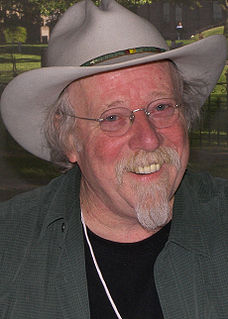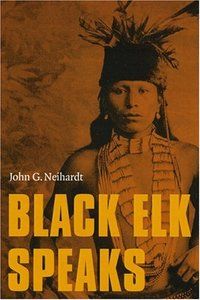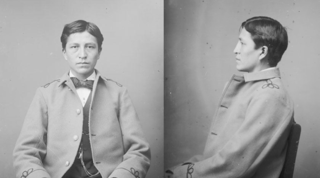| Bobby Bridger | |
|---|---|
 | |
| Box set by Bobby Bridger | |
| Released | 2000 |
| Recorded | Timberjack Joe's Tipi, Denver Sound Studios and Hill On The Moon Studios, 17–25 July 1975, 18–19 March 2000, and 4–6 April 2000. |
| Genre | Folk, acoustic, historical |
| Label | White Coyote Music, ASCAP |
A Ballad of the West is a three-part story by Bobby Bridger told in Homeric verse and song about the Mountain Men, William F. "Buffalo Bill" Cody, and the Lakota Sioux people inspired by John G. Neihardt's A Cycle of the West .

Bobby Bridger is a singer/songwriter/poet/actor/playwright/author and painter who for three decades has traveled the globe performing a trilogy of one man shows for audiences in America, Canada, Europe, Australia and Russia. He has recorded numerous albums for labels including Monument Records, RCA and Golden Egg Records. On television he appeared twice on the early years of PBS's "Austin City Limits", and on ABC's "Good Morning America", A & E and C-SPAN, as well as on NPR on radio. He is the composer of "Heal In The Wisdom", the official anthem of the Kerrville Folk Festival for over 25 years.

In the countable sense, a verse is formally a single metrical line in a poetic composition. However, verse has come to represent any division or grouping of words in a poetic composition, with groupings traditionally having been referred to as stanzas.

William Frederick "Buffalo Bill" Cody was an American scout, bison hunter, and showman. He was born in Le Claire, Iowa Territory, but he lived for several years in his father's hometown in Toronto Township, Ontario, Canada, before the family returned to the Midwest and settled in the Kansas Territory.
Part One: Seekers of the Fleece: This ballad presents the life story of mountain man Jim Bridger and the Fur Trade Era. Jim Bridger is Bobby Bridger's great granduncle. Beginning with Jim Bridger's historic ascension of the Missouri River with the Ashely-Henry Expedition in 1822, Seekers of the Fleece tells of the initial interactions between Euro-Americans and Native Americans, as well as the beginning of the American Emigration Era and the Indian Wars. This ballad was inspired by Alfred Jacob Miller's Western watercolors.

A mountain man is an explorer who lives in the wilderness. Mountain men were most common in the North American Rocky Mountains from about 1810 through to the 1880s. They were instrumental in opening up the various Emigrant Trails allowing Americans in the east to settle the new territories of the far west by organized wagon trains traveling over roads explored and in many cases, physically improved by the mountain men and the big fur companies originally to serve the mule train based inland fur trade.

James Felix Bridger was an American mountain man, trapper, Army scout and wilderness guide who explored and trapped the Western United States in the first half of the 19th century. Bridger is known for participating in numerous early expeditions into the western interior as well as mediating between Native American tribes and westward-migrating European-American settlers, and by the end of his life had earned a reputation as one of the foremost frontiersmen in the American Old West. He was of English ancestry, and his family had been in North America since the early colonial period.

Alfred Jacob Miller was an American artist best known for his paintings of trappers and Native Americans in the fur trade of the western United States. He also painted numerous portraits and genre paintings in and around Baltimore during the mid-nineteenth century.
Part Two: Pahaska: Pahaska is the Lakota word for "long hair," what the Sioux fondly called William F. "Buffalo Bill" Cody, and subsequently the name of the second ballad in the trilogy. Beginning with Buffalo Bill's birth in 1846, Pahaska chronicles Buffalo Bill's adventurous boyhood on the Great Plains, his career as a Pony Express rider, buffalo hunter, army scout, and his rise to global celebrity with the creation of the Wild West Show. Bobby Bridger also wrote a biography on Buffalo Bill recently published by the University of Texas Press, titled Buffalo Bill and Sitting Bull: Inventing the Wild West.
Lakota, also referred to as Lakhota, Teton or Teton Sioux, is a Siouan language spoken by the Lakota people of the Sioux tribes. Though generally taught and considered by speakers as a separate language, Lakota is mutually intelligible with the other two languages, and is considered by most linguists as one of the three major varieties of the Sioux language.

The Sioux, also known as Očhéthi Šakówiŋ, are groups of Native American tribes and First Nations peoples in North America. The term can refer to any ethnic group within the Great Sioux Nation or to any of the nation's many language dialects. The modern Sioux consist of two major divisions based on language divisions: the Dakota and Lakota.

The Great Plains is the broad expanse of flat land, much of it covered in prairie, steppe, and grassland, that lies west of the Mississippi River tallgrass prairie in the United States and east of the Rocky Mountains in the U.S. and Canada. It embraces:
Part Three: Lakota: Lakota begins with the meeting of Nebraska epic poet, John Neihardt, and the Lakota Holy Man, Black Elk, in South Dakota in 1931, of which would bring the famous book Black Elk Speaks . A 'telling of a telling of a telling,' Lakota presents Black Elk's recollections to Neihardt of the Indian Wars Era (1860–1890), Red Cloud and the Fetterman Massacre, the Battle of Little Big Horn, the deaths of Crazy Horse and Sitting Bull, travels with Buffalo Bill's Wild West Show, and the Massacre at Wounded Knee.
John Gneisenau Neihardt was an American writer and poet, amateur historian and ethnographer. Born at the end of the American settlement of the Plains, he became interested in the lives of those who had been a part of the European-American migration, as well as the Indigenous peoples whom they had displaced.
Heȟáka Sápa was a famous wičháša wakȟáŋ and heyoka of the Oglala Lakota (Sioux) who lived in the present-day United States, primarily South Dakota. He was a second cousin of the war chief Crazy Horse.

Black Elk Speaks is a 1932 book by John G. Neihardt, an American poet and writer, who relates the story of Black Elk, an Oglala Lakota medicine man. Black Elk spoke in Lakota and Black Elk's son, Ben Black Elk, who was present during the talks, translated his father's words into English. Neihardt made notes during these talks which he later used as the basis for his book.
A Ballad of the West was partially recorded in a tipi in the Colorado Rockies and completed in a 24 track studio in Denver in 1975 with Slim Pickens and The Lost Gonzo Band: John and Jim Inmon, Bob Livingston, Gary P. Nunn and Donnie Dolan. Slim's love of the mountain men brought him to volunteer his talents to narrate Seekers of the Fleece. Bridger has been performing A Ballad of the West around the globe for nearly four decades as a one-man show.

A tipi is a cone-shaped tent, traditionally made of animal skins upon wooden poles. Modern tipis usually have a canvas covering. A tipi is distinguished from other conical tents by the smoke flaps at the top of the structure. Historically, the tipi has been used by Indigenous people of the Plains in the Great Plains and Canadian Prairies of North America. They are still in use in these communities, though now primarily for ceremonial purposes rather than daily living. A similar structure, the lavvu is used by the Sámi people of northern Europe.

The Lost Gonzo Band was founded in 1973 and toured and recorded with many of Texas' most colorful musicians including Jerry Jeff Walker, Michael Martin Murphey and Ray Wylie Hubbard. The original members of the band were Bob Livingston, Gary P. Nunn, John Inmon, Kelly Dunn, Tomas Ramirez and Donny Dolan. Over the years, the band has also included Paul Pearcy, Craig D. Hillis, Herbert Steiner, Mike Holleman, Michael McGeary, Bobby Smith, Lloyd Maines, Radoslav Lorković and Riley Osbourn.

Robert Linlithgow Livingston Jr. is an American lobbyist and politician who served as a U.S. Representative from Louisiana from 1977 to 1999. A Republican, he was chosen as Newt Gingrich's successor as Speaker of the U.S. House of Representatives, a position he declined following revelations of his numerous extramarital affairs. A Republican, he served as a U.S. Representative from Louisiana from 1977 to 1999 and as the Chairman of the Appropriations Committee from 1995–1999. During his final years in congress, Livingston was a strong supporter of Bill Clinton's impeachment. He is currently a Washington, D.C.-based lobbyist. Livingston's memoir, The Windmill Chaser: Triumphs and Less in American Politics, was published in September 2018.













